Top 11 Infrastructure Monitoring Tools & Software Solutions 2025
Efficient monitoring tools are crucial for maintaining the performance, security, and reliability of your infrastructure. This comprehensive guide covers the top 11 best infrastructure monitoring tools and software solutions, offering insights into their features, benefits, and use cases. We'll help you choose the best monitoring systems for your IT environment in 2025.
What is Infrastructure Monitoring?
Infrastructure monitoring is the systematic practice of continuously observing, tracking, and analyzing the performance, availability, and health of IT infrastructure components including servers, networks, applications, databases, and cloud services. Unlike application performance monitoring (APM) which focuses on software-level metrics, infrastructure monitoring examines the underlying technology foundation that powers business applications.
Key components of infrastructure monitoring include:
- Server monitoring: CPU usage, memory utilization, disk performance, and system processes
- Network monitoring: Bandwidth usage, latency, packet loss, and device status
- Cloud infrastructure monitoring: Resource utilization, service availability, and cost optimization
- Database monitoring: Query performance, transaction rates, and storage utilization
- Security monitoring: Intrusion detection, vulnerability scans, and compliance tracking
Effective infrastructure monitoring enables IT teams to detect issues early, resolve problems quickly, prevent potential outages, and maintain optimal system performance. This proactive approach ensures seamless operations and positive user experiences while minimizing downtime costs.
For a comprehensive understanding of infrastructure monitoring concepts, implementation strategies, and best practices, see our detailed guide to infrastructure monitoring.
What to Monitor with Infrastructure Monitoring?
Infrastructure monitoring encompasses a wide range of metrics and components. Key aspects to monitor include:
- Server Health:
- CPU usage
- Memory utilization
- Disk space and I/O performance
- Network activity
- Network Performance:
- Bandwidth usage
- Latency and packet loss
- Network device status (routers, switches)
- Traffic patterns
- Application Performance:
- Response times
- Error rates
- Throughput
- Resource utilization
- Database Performance:
- Query performance
- Transaction rates
- Locking and blocking issues
- Storage utilization
- Security:
- Intrusion detection
- Log analysis
- Vulnerability scans
- Compliance monitoring
- Cloud Services:
- Service availability
- Cost management
- Resource scaling
- API performance
- User Experience:
- End-user response times
- Real user monitoring (RUM)
- Synthetic monitoring
- User journey tracking
By monitoring these critical aspects, organizations can ensure that their IT infrastructure remains robust, secure, and efficient.
Benefits of Infrastructure Monitoring
Effective infrastructure monitoring offers numerous benefits, including:
- Improved Performance and Uptime:
- Early detection of performance bottlenecks and issues helps prevent downtime.
- Proactive monitoring enables quick resolution of potential problems, maintaining high system availability.
- Enhanced Security:
- Continuous monitoring helps identify security threats and vulnerabilities in real-time.
- Timely alerts and log analysis aid in preventing data breaches and ensuring compliance with security standards.
- Cost Efficiency:
- Monitoring resource utilization helps optimize infrastructure, reducing unnecessary costs.
- Avoiding downtime and performance issues minimizes financial losses associated with outages.
- Better Decision Making:
- Access to detailed performance data enables informed decision-making and strategic planning.
- Historical data analysis helps in capacity planning and future-proofing the IT environment.
- Increased Operational Efficiency:
- Automated monitoring and alerting reduce the need for manual intervention, freeing up IT resources.
- Streamlined troubleshooting processes enhance overall operational efficiency.
- Enhanced User Experience:
- Monitoring end-user experiences ensures that applications and services meet user expectations.
- Improved performance and reliability lead to higher customer satisfaction and retention.
By leveraging the benefits of infrastructure monitoring, organizations can achieve a more stable, secure, and efficient IT environment, ultimately supporting business growth and success.
Infrastructure Monitoring Tools
| Tool | Category | Best For | Pricing | Deployment |
|---|---|---|---|---|
| Uptrace | Observability | Distributed Systems | Open Source | Cloud/On-Premise |
| Middleware | Infrastructure | Real-time Monitoring | Paid | Cloud |
| Datadog | Full-Stack | Large Enterprises | Paid | Cloud |
| Nagios | Infrastructure | Custom Monitoring | Free/Paid | On-Premise |
| Zabbix | Infrastructure | Enterprise | Free | On-Premise |
| SolarWinds NPM | Network | Network Performance | Paid | On-Premise |
| PRTG | All-in-One | Small-Medium Business | Paid | On-Premise |
| Splunk | Log Analysis | Security/Compliance | Paid | Cloud/On-Premise |
| Prometheus | Metrics | Cloud-Native | Free | On-Premise |
| New Relic | APM | Application Performance | Paid | Cloud |
| Grafana | Visualization | Dashboard Creation | Free | On-Premise |
IT Infrastructure Monitoring Platforms
Comprehensive IT infrastructure monitoring platforms provide unified visibility across all infrastructure components, combining server monitoring, network monitoring, application monitoring, and cloud monitoring capabilities in a single solution. These platforms are designed to eliminate monitoring silos and provide holistic infrastructure observability.
Key characteristics of IT infrastructure monitoring platforms include:
- Centralized dashboards and reporting
- Cross-component correlation and analysis
- Unified alerting and incident management
- Integration with ITSM and DevOps tools
- Scalable architecture for enterprise environments
Uptrace
Uptrace is a modern, distributed tracing system that is highly effective for monitoring and observability of complex IT infrastructures. Designed to provide deep insights into system performance and reliability, Uptrace is an invaluable tool for IT and DevOps teams.
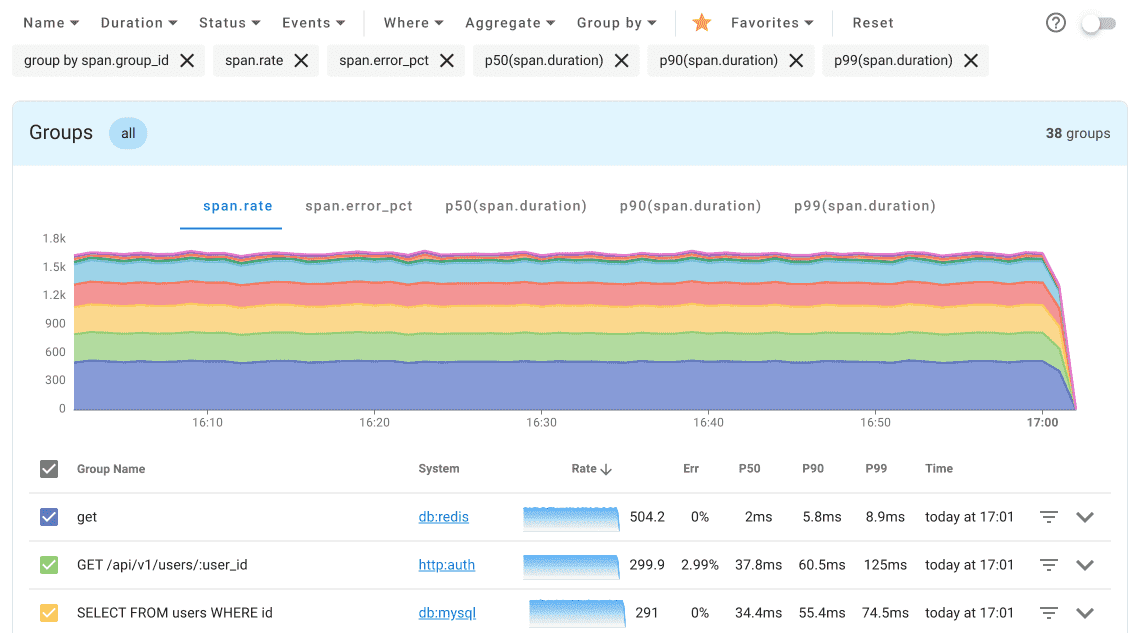
Features:
- Distributed tracing with advanced visualization
- Seamless integration with popular data sources
- Real-time monitoring with customizable dashboards
- Powerful query language for detailed analysis
Benefits:
- Provides detailed insights into application performance
- Facilitates quick identification and resolution of issues
- Scales effortlessly with growing infrastructure needs
- Open-source with active community support
Use Case Uptrace is ideal for organizations needing detailed observability into their distributed systems. For instance, an e-commerce company with a complex microservices architecture can use Uptrace to trace customer transactions across various services. This helps in identifying performance bottlenecks, ensuring that users have a seamless shopping experience. Real-time monitoring and alerting capabilities enable the IT team to quickly detect and address issues, minimizing downtime and maintaining high availability.
Discover observability platforms for unified monitoring approaches.
Server Monitoring Tools & Software
Server monitoring software focuses on tracking the health and performance of physical and virtual servers, including CPU usage, memory consumption, disk space, and system processes. These monitoring tools help prevent downtime by alerting administrators to potential hardware failures or resource exhaustion before they impact users.
Modern server monitoring solutions provide comprehensive visibility into server performance metrics, automated alerting capabilities, and detailed reporting for capacity planning and troubleshooting.
Zabbix
Zabbix is a powerful open-source monitoring tool that offers robust features for monitoring and managing IT infrastructure, particularly excelling in server monitoring scenarios.
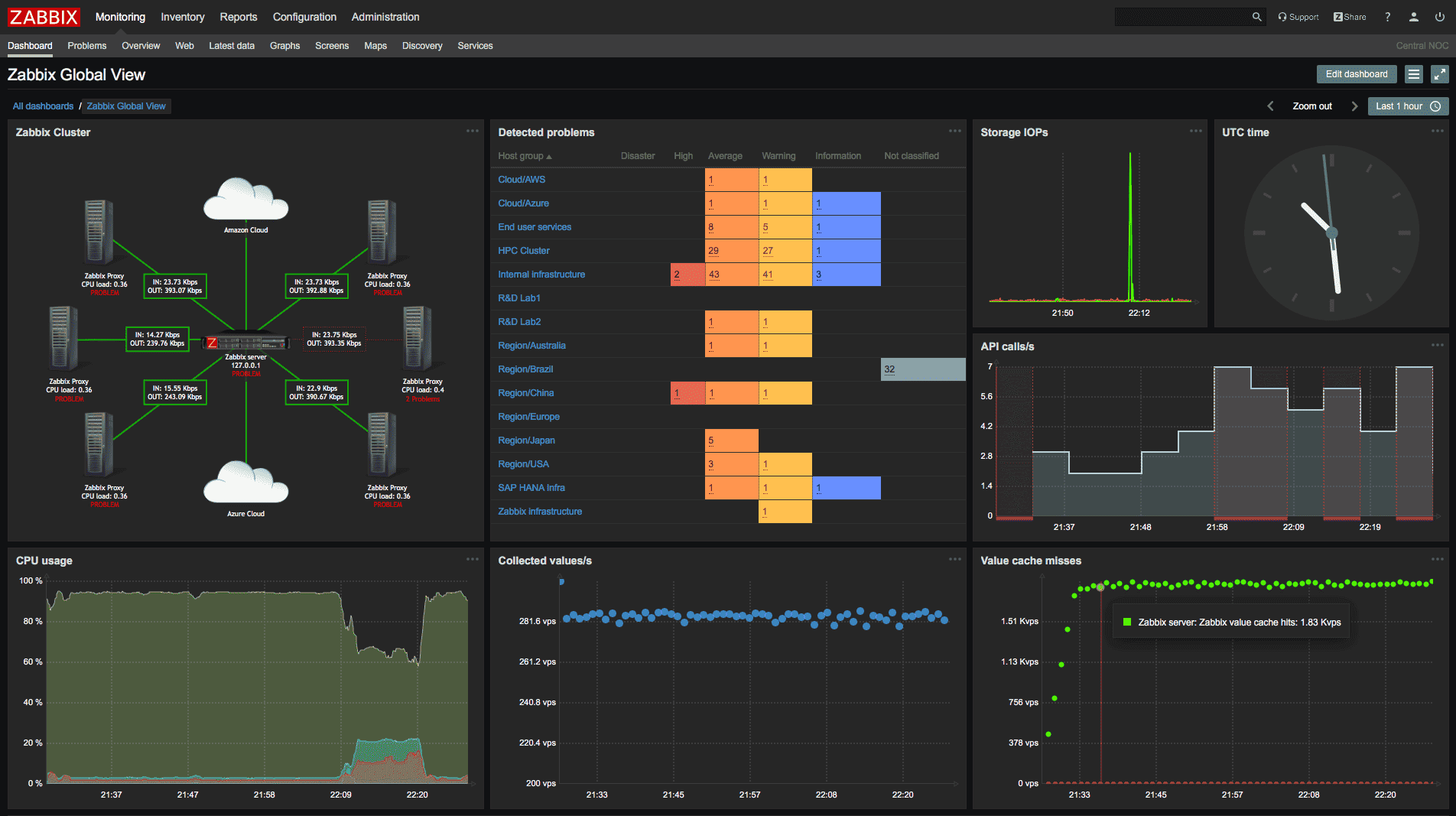
Features:
- Agent-based and agentless monitoring
- Scalability for large environments
- Advanced visualization with customizable dashboards
- Intelligent alerting and remediation actions
Benefits:
- No licensing costs for the core product
- High flexibility and customization options
- Strong community support
Use Case Zabbix is suitable for medium to large enterprises seeking a free, scalable monitoring solution. For example, a telecommunications company can use Zabbix to monitor its vast network infrastructure, including servers, routers, and switches. The tool's scalability ensures that as the network grows, Zabbix can handle the increased monitoring demands without performance degradation. Intelligent alerting helps the network operations center (NOC) quickly address issues before they impact service delivery.
PRTG Network Monitor
PRTG Network Monitor by Paessler is an all-in-one monitoring solution designed to monitor various aspects of IT infrastructure, with strong server monitoring capabilities.
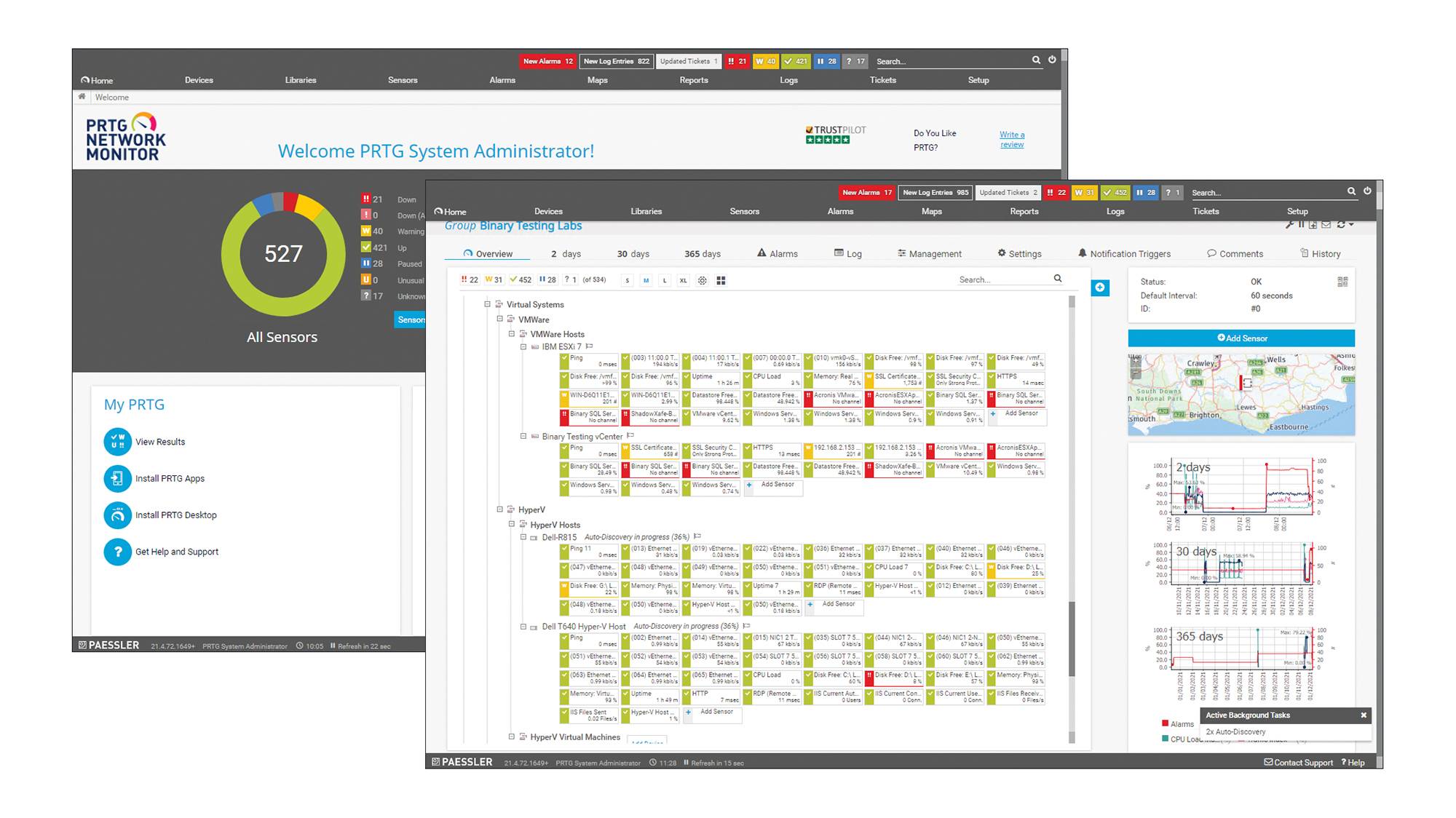
Features:
- Multi-faceted monitoring for servers, networks, and applications
- Easy-to-use web-based interface
- Scalable with clustering and failover options
- Customizable alerts and notifications
Benefits:
- Provides a holistic view of IT infrastructure
- User-friendly with minimal setup and configuration
- Supports a wide range of monitoring scenarios
Use Case PRTG Network Monitor is great for businesses of all sizes looking for a comprehensive, easy-to-use monitoring solution. For example, a small-to-medium-sized enterprise (SME) can deploy PRTG to monitor its entire IT infrastructure, including servers, workstations, and network devices. The tool's scalability ensures that as the business grows, the monitoring setup can expand without requiring significant changes. Customizable alerts help the IT team stay on top of potential issues, ensuring smooth operations.
Cloud Monitoring Solutions
Cloud monitoring tools provide visibility into cloud-based infrastructure, tracking resource utilization, service availability, and cost optimization across multiple cloud providers. These solutions are essential for managing dynamic, scalable cloud environments and differ from traditional monitoring by offering features like auto-discovery, API integration with cloud providers, and support for containerized applications.
Cloud infrastructure monitoring addresses unique challenges such as:
- Dynamic resource scaling and allocation
- Multi-region performance monitoring
- Cloud-specific cost optimization
- Integration with cloud-native services
- Container and orchestration platform monitoring
Datadog
DataDog is a cloud-based monitoring and analytics platform designed for IT and DevOps teams. It offers comprehensive monitoring solutions for infrastructure, applications, logs, and more.
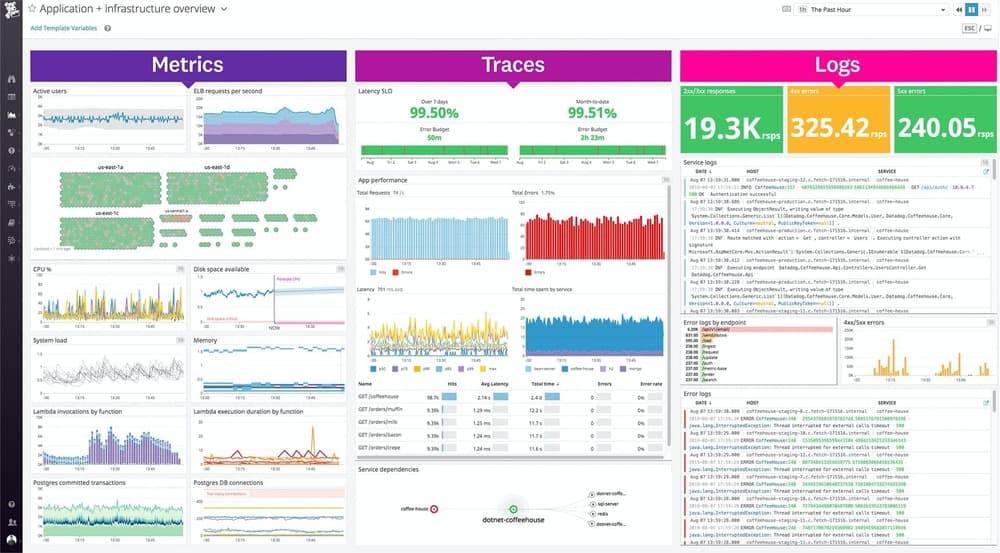
Features:
- Real-time monitoring with customizable dashboards
- Seamless integration with over 450 technologies
- Advanced alerting and machine learning-based anomaly detection
- Distributed tracing and APM (Application Performance Monitoring)
Pros:
- Excellent visualization and dashboard capabilities
- Strong integration ecosystem (450+ integrations)
- Machine learning-powered anomaly detection
- Unified platform for metrics, logs, and traces
- Good collaboration features for DevOps teams
Cons:
- Can become expensive with high data volumes
- Complex pricing structure
- Steep learning curve for advanced features
- Vendor lock-in concerns
- Limited data retention in basic plans
Pricing: Free tier for up to 5 hosts, Pro starts at $15/host/month, Enterprise at $23/host/month
Use Case Datadog is ideal for large-scale enterprises needing detailed insights into complex cloud environments. For example, a financial services company with a highly distributed system can leverage Datadog to monitor their microservices architecture, ensuring that all transactions are processed efficiently and securely. The platform's real-time alerting can notify the IT team of any potential issues before they impact customers, maintaining high levels of service availability.
Middleware
Middleware Infrastructure Monitoring is a comprehensive solution that provides real-time visibility into your infrastructure's performance across various environments, operating systems, and orchestration tools. It helps identify hidden inefficiencies and optimize your infrastructure for peak performance.
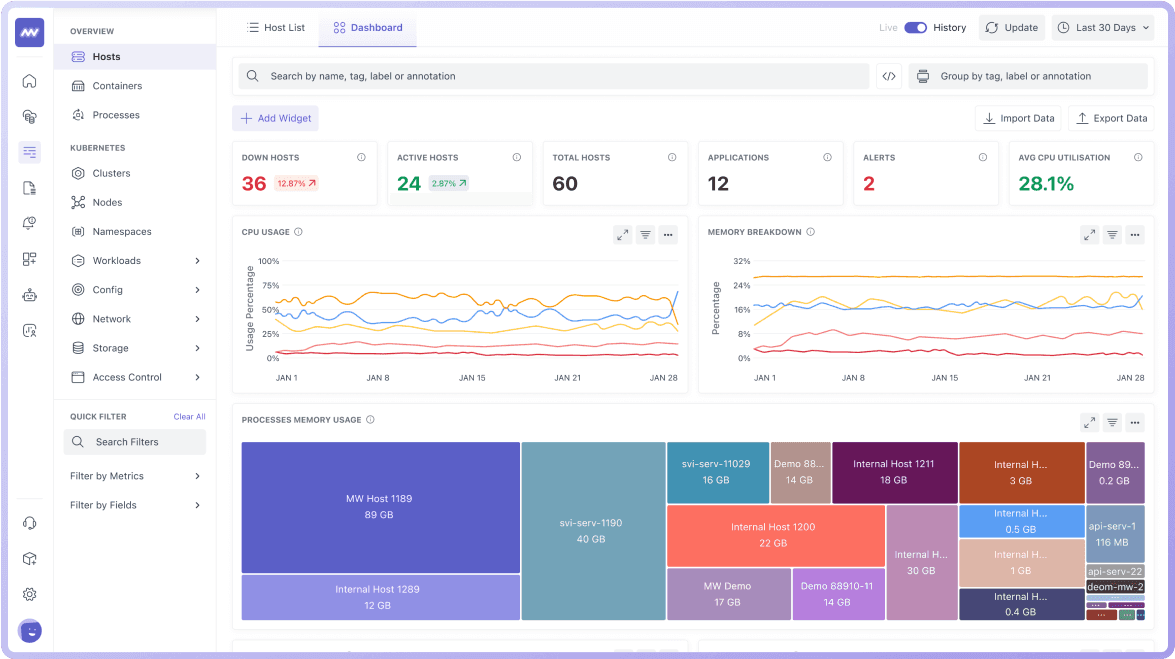
Features:
- Real-time insight into your infrastructure's performance through thousands of metrics, including CPU utilization, memory usage, and resource status.
- Through a single click, correlate metrics, traces, and logs to quickly identify and resolve issues, making root cause analysis much more efficient.
- Make your monitoring experience tailored to the business needs, such as customized dashboards, alert thresholds, and metrics.
- It comes with comprehensive dashboards for the different infrastructure components, including virtual machines, on-premises servers, containers, and cloud-hosted machines, and one can customize these as per requirements.
- Monitor Kubernetes clusters, nodes, and pods performance using the default dashboards or drill down to related resources.
- Raise alerts on performance metrics, receive real-time notifications to reduce mean time to detect (MTTD), and set alert thresholds according to key performance indicators.
Benefits:
- By revealing hidden inefficiencies, the tool helps optimize your infrastructure for peak performance.
- Real-time insight and rapid problem-solving capabilities facilitate proactive identification and resolution of problems before they become an issue to end-users.
- The solution scales effortlessly with your enterprise needs, accommodating growth and changes in your infrastructure.
Use Case:
Middleware's Infrastructure Monitoring suits organizations that require comprehensive visibility and control over their IT environments. For instance, a technology company with a hybrid infrastructure of on-premises servers and cloud services can use this tool to monitor performance metrics across all systems. The customizable dashboards allow IT teams to focus on critical metrics, while intelligent alerting ensures prompt attention to potential issues, thereby maintaining optimal system performance and reliability.
Open Source Monitoring Tools
Open source monitoring solutions provide cost-effective alternatives to commercial platforms while offering high levels of customization and community support. These tools are particularly valuable for organizations with specific monitoring requirements or budget constraints.
Nagios
Nagios is one of the most popular open-source monitoring tools, known for its flexibility and extensive plugin ecosystem.
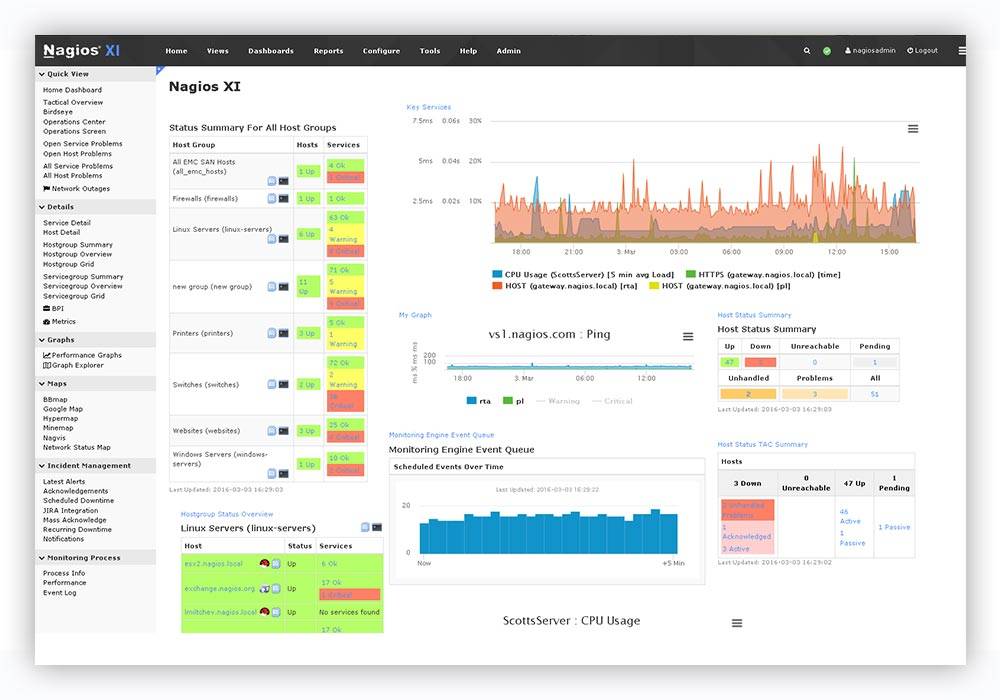
Features:
- Comprehensive monitoring of servers, networks, and applications
- Customizable alerting and reporting
- Extensive library of plugins for extended functionality
- Community support and a large user base
Benefits:
- Highly customizable to meet specific needs
- Cost-effective with a free core version
- Proven reliability in various environments
Use Case Nagios is best for organizations looking for a customizable and open-source monitoring solution. For instance, a mid-sized IT service provider can use Nagios to monitor client networks and servers, customizing the monitoring parameters to suit each client's unique needs. The extensive plugin library allows the provider to extend Nagios's capabilities to cover a wide range of devices and applications, ensuring comprehensive monitoring across their client base.
Prometheus
Prometheus is an open-source monitoring and alerting toolkit designed for reliability and scalability.
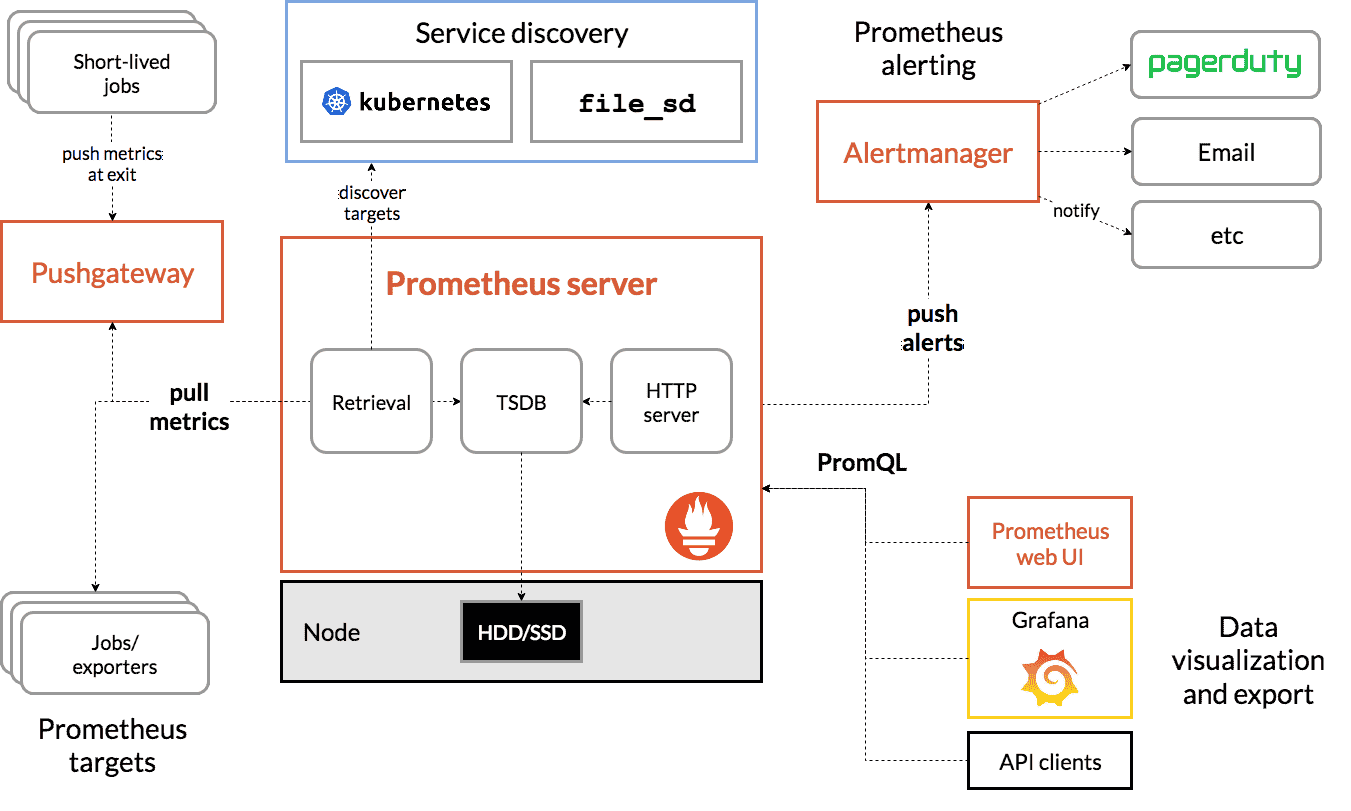
Features:
- Powerful query language (PromQL) for data analysis
- Time-series data storage and visualization
- Robust alerting capabilities
- Integration with Grafana for enhanced visualization
Benefits:
- Excellent for monitoring dynamic, cloud-native environments
- Scalable and reliable for large-scale deployments
- Active open-source community and extensive documentation
Use Case Prometheus is ideal for organizations with cloud-native or containerized environments. For example, a tech startup running microservices on Kubernetes can use Prometheus to monitor application performance and resource usage. The tool's powerful query language allows the team to create custom metrics and alerts, ensuring that any issues are quickly identified and resolved. Integration with Grafana provides detailed visualizations that help in understanding and optimizing the application's performance.
Network Monitoring Solutions
Network monitoring solutions focus specifically on network infrastructure performance, including bandwidth utilization, device health, and connectivity issues. While comprehensive infrastructure monitoring platforms include network monitoring capabilities, specialized network monitoring tools provide deeper insights into network-specific metrics and protocols.
For organizations requiring detailed network performance analysis, traffic pattern recognition, and network security monitoring, dedicated network monitoring solutions offer specialized features that may not be available in general-purpose infrastructure monitoring tools.
SolarWinds NPM
SolarWinds NPM is a powerful and user-friendly monitoring tool tailored for network performance monitoring.
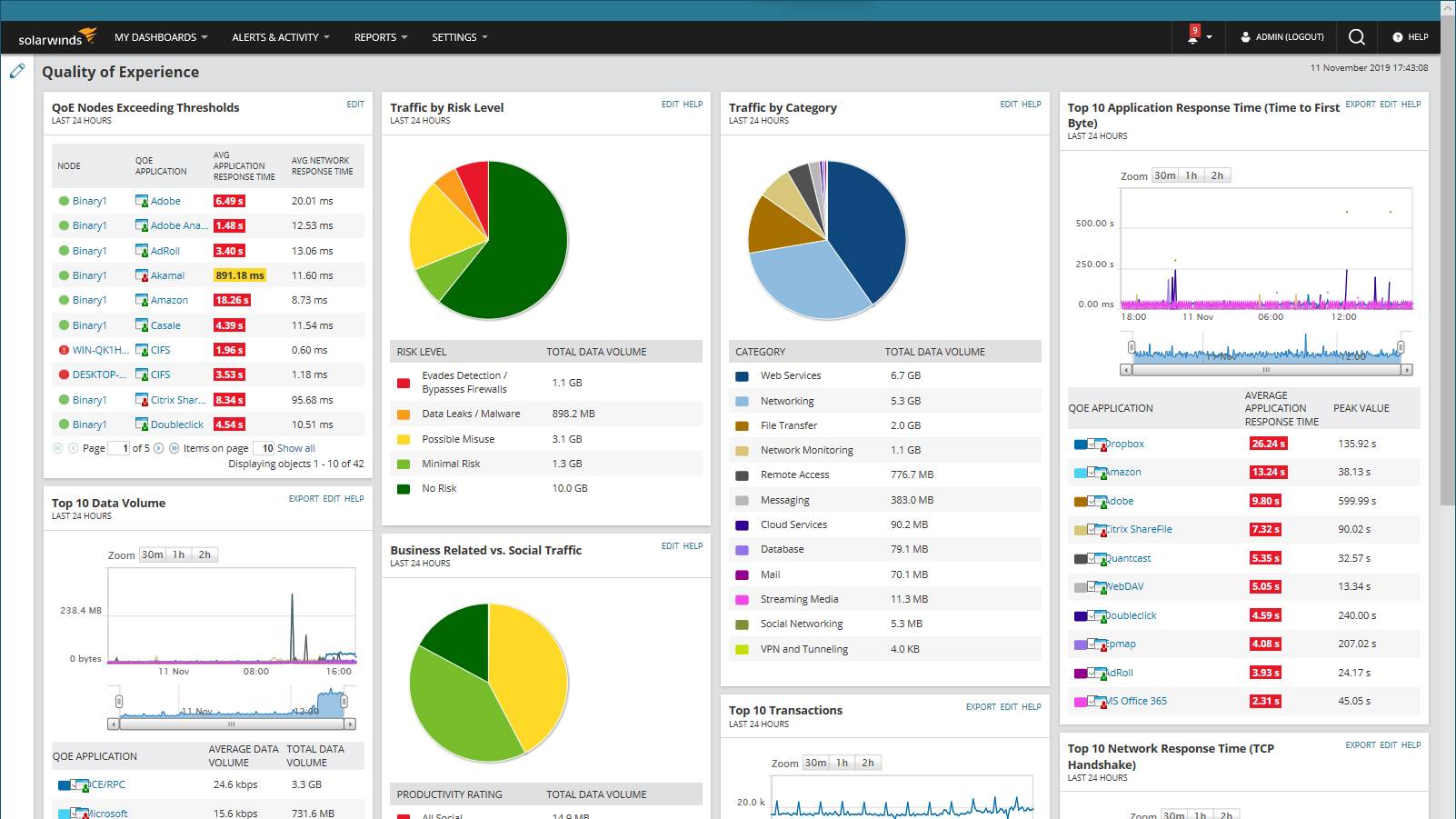
Features:
- Comprehensive network performance monitoring and diagnostics
- Intuitive and customizable dashboards
- Automated network discovery and mapping
- Advanced alerting and reporting capabilities
Benefits:
- Simplifies network troubleshooting and performance optimization
- Reduces downtime with proactive monitoring
- Scales to support large networks
Use Case SolarWinds NPM is ideal for IT departments focused on maintaining optimal network performance. For instance, a large university campus with a complex network of switches, routers, and wireless access points can use NPM to monitor network health and performance. The automated network discovery feature helps quickly map out the network, while customizable dashboards provide at-a-glance insights into key performance metrics. Advanced alerting ensures that the network team is immediately aware of any issues, reducing the time to resolution.
For specialized network monitoring, see our detailed network monitoring tools comparison.
Application Performance Monitoring
While infrastructure monitoring focuses on the underlying technology stack, application performance monitoring (APM) tools specifically track software-level metrics from an end-user perspective. APM solutions monitor application response times, error rates, and user experiences to ensure applications perform optimally.
New Relic
New Relic One offers a suite of tools for monitoring and managing the performance of your applications and infrastructure.
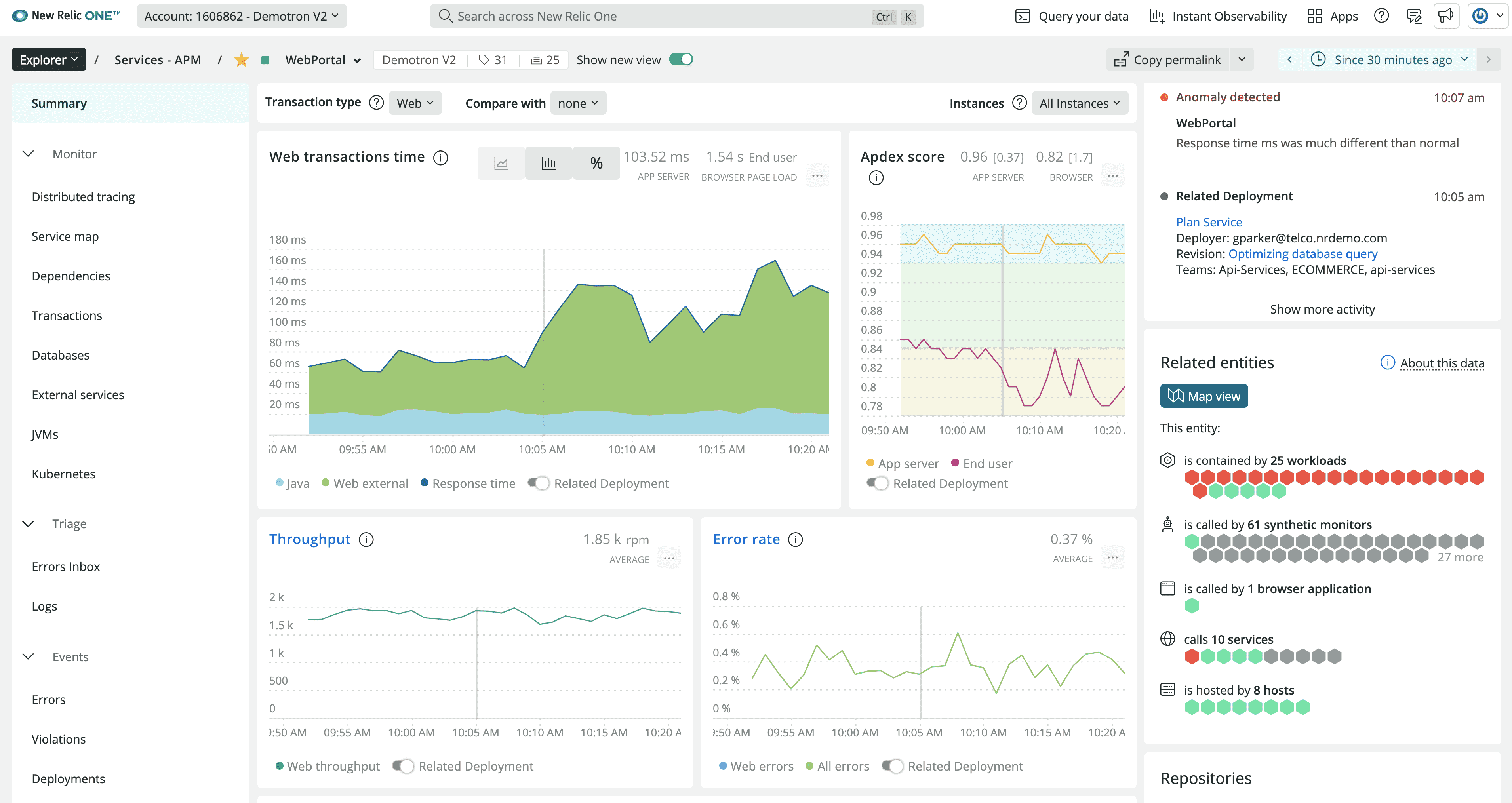
Features:
- Comprehensive APM (Application Performance Monitoring)
- Real-time user monitoring and synthetic monitoring
- Detailed transaction tracing
- Customizable dashboards and reporting
Benefits:
- Provides deep insights into application performance
- Enhances user experience with real-time monitoring
- Scales with your application's growth
Use Case New Relic is perfect for companies needing detailed application performance insights. For instance, an online retail company can use New Relic to monitor its e-commerce platform, ensuring that users experience fast and reliable service. Real-time monitoring helps identify slow transactions and errors, enabling quick resolution and improved user satisfaction. Synthetic monitoring allows the company to test different scenarios and optimize the platform's performance proactively.
Learn more about application performance monitoring tools for deeper application insights.
Specialized Monitoring Tools
Splunk
Splunk is a powerful platform for searching, monitoring, and analyzing machine-generated data in real-time.

Features:
- Advanced log management and analysis
- Real-time monitoring and alerting
- Scalable to handle large volumes of data
- Integration with a variety of data sources
Benefits:
- Provides deep insights into IT operations and security
- Enhances decision-making with real-time analytics
- Scales with the growth of your data
Use Case Splunk is best for organizations needing powerful log analysis and real-time monitoring. For instance, a cybersecurity firm can use Splunk to monitor security logs and detect potential threats in real-time. The platform's advanced analytics capabilities allow for quick identification of unusual patterns and behaviors, ensuring that security incidents are captured and analyzed, providing a comprehensive view of the security landscape.
Explore log analysis tools for comprehensive log management solutions.
Grafana
Grafana is a popular open-source platform for monitoring and observability, known for its powerful visualization capabilities.
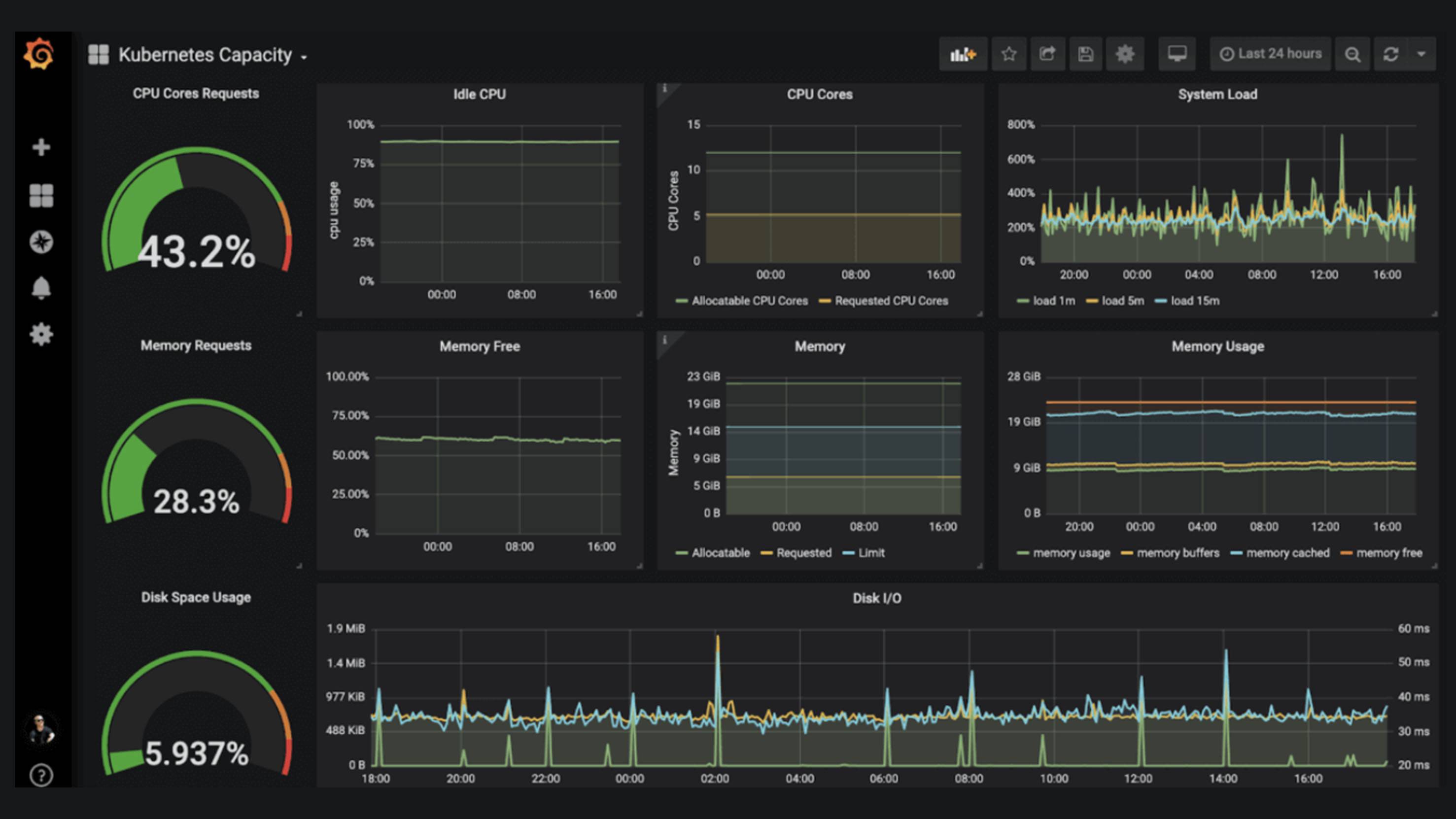
Features:
- Advanced visualization with customizable dashboards
- Integration with various data sources (Prometheus, Elasticsearch, etc.)
- Real-time alerting and notification system
- Extensive plugin ecosystem
Benefits:
- Enhances data visualization and analysis
- Integrates seamlessly with multiple monitoring tools
- Supports a wide range of use cases
Use Case Grafana is suitable for organizations needing advanced visualization for their monitoring data. For instance, a healthcare provider can use Grafana to visualize patient data from various monitoring systems, ensuring that critical metrics are easily accessible to healthcare professionals. The tool's customizable dashboards allow for tailored views that meet the specific needs of different departments, enhancing decision-making and patient care.
Conclusion
Choosing the right infrastructure monitoring tools and software solutions is essential for maintaining the performance, security, and reliability of your IT infrastructure. Whether you need comprehensive monitoring platforms like Uptrace or specialized tools like Grafana and Prometheus, the options listed above provide robust features and benefits to meet your organization's needs. By carefully evaluating the use cases and capabilities of each tool, you can ensure that you select the best monitoring systems for your IT environment.
Incorporating these top monitoring tools into your IT infrastructure strategy will help you achieve better visibility, faster issue resolution, and improved overall performance. Whether you're managing a small network or a complex cloud environment, the right tools can make all the difference.
FAQ
- What should I monitor in my IT infrastructure? Key areas to monitor include server health (CPU, memory, disk usage), network performance (bandwidth, latency), application performance (response times, error rates), database performance (query times, transactions), security metrics, and user experience metrics.
- What's the difference between infrastructure monitoring and server monitoring? Infrastructure monitoring encompasses the entire IT environment including servers, networks, applications, databases, and cloud services, while server monitoring focuses specifically on individual server performance and health metrics like CPU usage, memory consumption, and disk space.
- How do open-source and commercial monitoring software compare? Open-source tools like Prometheus and Grafana offer flexibility and cost-effectiveness but may require more setup and maintenance. Commercial solutions like Datadog and New Relic provide more out-of-box functionality and support but come with subscription costs. Consider your technical expertise, budget, and support requirements when choosing.
- How does cloud monitoring differ from traditional infrastructure monitoring? Cloud monitoring tools are designed for dynamic, scalable environments and offer features like auto-discovery, API integration with cloud providers, cost optimization tracking, and support for containerized applications. Traditional monitoring focuses more on static, on-premises infrastructure with predictable resource allocation.
- Which monitoring tool is best for cloud environments? Tools like Datadog and New Relic excel in cloud environments with native integration for major cloud providers. Uptrace and Prometheus are also strong choices for cloud-native architectures, especially when working with containerized applications.
- What about monitoring tools for smaller organizations? Smaller organizations might start with tools like PRTG or Zabbix, which offer good functionality without overwhelming complexity. Uptrace provides a balanced solution that can scale with your growth while remaining cost-effective.
- How do these tools handle scalability? Most modern monitoring tools are designed to scale, but their approaches differ:
- Datadog and New Relic scale automatically in the cloud
- Prometheus requires additional setup for large-scale deployments
- Uptrace offers efficient scalability through its architecture
- Tools like Nagios and Zabbix can handle growth but may need more configuration
- What are the cost considerations when choosing a monitoring tool? Costs vary significantly:
- Open-source tools (Prometheus, Grafana) have no licensing costs but require infrastructure and maintenance
- Commercial tools (Datadog, New Relic) typically charge based on hosts, metrics, or data volume
- Some tools like Uptrace offer more predictable pricing models
- Consider both direct costs and maintenance overhead in your evaluation
- How important is visualization in monitoring tools? Visualization is crucial for understanding complex data and identifying trends. Tools like Grafana excel in this area, while platforms like Uptrace and Datadog provide built-in visualization capabilities. Consider how the tool presents data and whether it meets your team's needs for analysis and reporting.
- What about integration capabilities? Modern monitoring tools should integrate well with your existing stack:
- Consider support for your programming languages and frameworks
- Look for integration with your cloud providers and services
- Check compatibility with your existing tools and workflows
- Evaluate the availability of APIs and plugins
- Which monitoring software is best for servers? For server monitoring, tools like Zabbix, PRTG, and Nagios excel at tracking server health metrics including CPU, memory, disk usage, and system processes. These tools provide comprehensive server monitoring capabilities with customizable alerting.
- What are monitoring systems vs monitoring tools? Monitoring systems refer to comprehensive platforms that combine multiple monitoring capabilities (infrastructure, application, network, security) in a unified solution, while monitoring tools typically focus on specific aspects like network, application, or server monitoring. Systems provide broader visibility and correlation across different infrastructure components.
You may also be interested in: